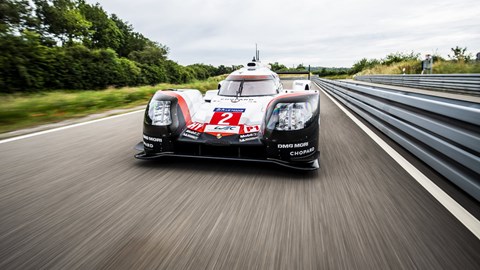► We speak to Nick Tandy, 2015 Le Mans winner
► What to look out for this year
► Why Hypercars have to be treated differently
Last year’s race was one of the most chaotic in years, but the 2024 race – on paper at least – promises to be even more extreme. Six manufacturers have shown strong form at some point in the week-long run-up to the race, with the drivers all tipping each other as favourites.
A finely-matched pack suggests close, aggressive racing – but according to Porsche’s Nick Tandy (who currently races in IMSA and now pilots the third works #4 Porsche) you won’t really have an idea of who’s in the mix until three or four hours in – or even tomorrow. That’s because, unlike the flat-out times of the old LMP1 regulation cars, these Hypercar-era racers require an element of conservation.

Bringing it home
‘In LMP1 we were flat out because you couldn’t take kerbs, because the cars were so low and they wouldn’t ride the kerbs,’ Tandy tells us. ‘Everything was so stiff and it was quite lightweight. So, you just you kind of drove flat out all the time.’
In contrast, the road-car-like Hypercars can take kerbs and gain laptime doing it. ‘[With a LMP1] if you hit a kerb, it’d bounce you off and you’d be slow, whereas our car – because you have to handle this mass – they’re a little bit softer. You can take the kerb and it’s fast, but it does wear the car out.’

‘The dampers and everything get worn out and even with the best of stuff, things will fail, and oil degrades. The bodywork degrades through the whole race as it becomes peppered by stones, the floor wears out as it’s rubbing.’
‘I know back in the day you had to protect the engine, the gearbox, the brakes, everything like that,’ Tandy tells us. ‘There’s nothing like that. It’s just how you manage the suspension degradation and bodywork degradation.’
So what’s the plan?
With that in mind, the best course of action – at least according to Tandy, who we’d trust being a Le Mans winner – is to conserve the car for the first half of the race, and then slowly move towards the front in the early hours.
‘The first hour is a great show because the race starts, everyone’s watching and everyone’s talking about the cars fighting at the front of the grid,’ Tandy admits. ‘But we know as a team, and I know as a driver; let them fight the front, we’ll steadily try and work our way forward.’

‘The show, the first three hours that everyone’s watching on TV, you know, we’re likely not going to be around there because we’re starting further back – but let them wear their cars out. Let them use all their tyres. If the car’s good and reliable, we will be there the last eight, four hours of the race. That’s the plan.’
Of course, nothing ever goes to plan – so if you’re Porsche you ensure there’s six 963 Hypercars in total entered in the race; three works cars (including Tandy’s #4 car) two Hertz-Jota cars and one Proton car. That’ll put the odds in their favour.